

The CEPT University Library, Ahmedabad by Rahul Mehrotra: Spaces within the spaces

The CEPT University Library, called the Lilavati Lalbhai Library, opened in 2017. It was the first structure on the CEPT campus that architect BV Doshi had not designed, and architect Rahul Mehrotra—an alumnus of CEPT, and Lead Architect of RMA Architects—says that he found this intimidating and challenging.
However, the library today integrates seamlessly into the overall plan due to the eclectic nature of the architectural language of CEPT, as well as the detailed analysis conducted on the proposed site.

Design Philosophy
The CEPT University Library was designed to promote the connection and integration of faculty and students from the various academic departments. Rahul Mehrotra, envisioned the building as a source of inspiration and innovation for the students, beyond a mere repository of books.
The library was intended as an expression of the University’s shift towards a more choice-based pedagogy, and an exhibition of the reinterpretation of climate-responsive architecture.
Situated at a critical central point in the campus plan, the library naturally serves as a pivotal linking space, which is further emphasized by the convenient entrances at all the cardinal points that allow access into the building.

Design and Materiality
Three distinct spaces layered within each other, like tree rings, fulfill the basic concept of the building. The first area is the exterior space designed to combat the harsh climate of Ahmedabad by acting as the ‘skin’ of the building.
The second layer is made of wide spaces meant to flood the structure with light. This second layer is created as an intermediate space between the skin and the core. The final layer, or the library core, contains the stack space and the more private reading areas and is made of steel and glass along with concrete.
The interlocking of these different layers is responsible for creating a variety of different, interesting spaces within the library, 12 types in total. Mehrotra wished for these spaces to act as founts for learning and mental stimulation. The variety of spaces allow for greater convenience and flexibility of library usage.

Spaces Within the Library
The CEPT University Library follows and reinvents the existing architectural language. The site of the library is based on the original masterplan of the University, and the building is aligned with the pre-existing buildings.

Mehrotra restricted the height of the structure to match the existing context and then built it downwards such that half of the building is buried, which provides the added advantage of temperature control. The library core extends down to these basement levels, with quieter spaces for reading and archiving.
Seminar rooms and administrative areas are also present within this core. The upper levels contain the exhibition and collaboration spaces, and some open directly to the campus, promoting more informal, inviting spaces within and around the library.

Lower height spaces meant to simulate intimacy and privacy make up the internal library core, in contrast to the other layers. Mehrotra wanted to create the sense that students would feel the same comfort within the building that they would within their homes or rooms.
Thus, in the basement levels, he created spaces through a variety of spaces for group work and ‘carrels’, which are specially designed nooks for individual study. The structural elements are integrated within the stack spaces to create a sense of ambiguity about the depth of the building.
The lowest level is used as archival spaces and storage. The core also functions as a repository for multi-format media, to maintain the University standards of knowledge.

Shifting Facade
More flexible spaces that also connect the building with the natural context are present in the upper levels. The skin of the building plays an important role in this. While the internal layers are made of structural steel, concrete, and glass, the skin has a material palette of concrete and wooden louvers.
Louvers are an effective method of passive temperature control and have been used as a façade element before, such as in the Mill Owners’ Association building. However, rather than a rigid, fixed structure of vertical fins, Mehrotra reimagined the concept.
The wooden louvers in the CEPT University Library are an integral part of both the architectural vocabulary as well as the functioning of the building. The louvers can be manually angled at different orientations to control the flow of light and air into the building based on student requirements.

This constant shift in light and shadow adds a new element of interest, while also serving as a demonstration of passive architectural climatic control techniques. The whole building, therefore, behaves as a learning tool for the students on the topics of lighting, ventilation, and temperature control strategies, while also easing their experience within the building.
The louvers are present on the upper levels of the building, where various types of reading spaces are present for multiple methods of learning ranging from collaborative to individual.

Since its opening, the CEPT library has been fully integrated both into the architectural language of the campus and also into the student culture, acting as a focal point for interaction and discussion, as well as for self-study and reflection.

Mythili Nair is an aspiring architect and lifelong student. She loves to discover the various ways architecture impacts culture, society and experiences, and firmly believes in sustainability and inclusivity.

India House, Pune by Christopher Charles Benninger: Inspired by Traditions

Belapur Housing by Charles Correa: A sense of home and community
Related posts.

Bombay Art Society, Mumbai

Favela Nova Jaguaré by Boldarini Arquitetos Associados

La Martiniere College, Lucknow

Karle Town Centre: A Smart city master planned by UNStudio

Jubail Mangrove Park, Abu Dhabi

The Art Science Museum by Moshe Safdie
- Architectural Community
- Architectural Facts
- RTF Architectural Reviews
- Architectural styles
- City and Architecture
- Fun & Architecture
- History of Architecture
- Design Studio Portfolios
- Designing for typologies
- RTF Design Inspiration
- Architecture News
- Career Advice
- Case Studies
- Construction & Materials
- Covid and Architecture
- Interior Design
- Know Your Architects
- Landscape Architecture
- Materials & Construction
- Product Design
- RTF Fresh Perspectives
- Sustainable Architecture
- Top Architects
- Travel and Architecture
- Rethinking The Future Awards 2022
- RTF Awards 2021 | Results
- GADA 2021 | Results
- RTF Awards 2020 | Results
- ACD Awards 2020 | Results
- GADA 2019 | Results
- ACD Awards 2018 | Results
- GADA 2018 | Results
- RTF Awards 2017 | Results
- RTF Sustainability Awards 2017 | Results
- RTF Sustainability Awards 2016 | Results
- RTF Sustainability Awards 2015 | Results
- RTF Awards 2014 | Results
- RTF Architectural Visualization Competition 2020 – Results
- Architectural Photography Competition 2020 – Results
- Designer’s Days of Quarantine Contest – Results
- Urban Sketching Competition May 2020 – Results
- RTF Essay Writing Competition April 2020 – Results
- Architectural Photography Competition 2019 – Finalists
- The Ultimate Thesis Guide
- Introduction to Landscape Architecture
- Perfect Guide to Architecting Your Career
- How to Design Architecture Portfolio
- How to Design Streets
- Introduction to Urban Design
- Introduction to Product Design
- Complete Guide to Dissertation Writing
- Introduction to Skyscraper Design
- Educational
- Hospitality
- Institutional
- Office Buildings
- Public Building
- Residential
- Sports & Recreation
- Temporary Structure
- Commercial Interior Design
- Corporate Interior Design
- Healthcare Interior Design
- Hospitality Interior Design
- Residential Interior Design
- Sustainability
- Transportation
- Urban Design
- Host your Course with RTF
- Architectural Writing Training Programme | WFH
- Editorial Internship | In-office
- Graphic Design Internship
- Research Internship | WFH
- Research Internship | New Delhi
- RTF | About RTF
- Submit Your Story
Looking for Job/ Internship?
Rtf will connect you with right design studios.

Lilavati Lalbhai Library by RMA Architects
Ahmedabad, india.

RMA’s library is the first building on the CEPT campus not designed by Balkrishna Doshi, the school’s founder. It defers to the earlier brick-and-concrete buildings but distinguishes itself with a much lighter facade made up primarily of operable wood louvers.
Photo © Rajesh Vora

Photo © Tina Nandi

To avoid exceeding the height of the existing campus buildings, the architects submerged three of the library’s six stories below grade. Light filters through the adjustable louvers, reaching almost to the building’s lowest levels.

The library resembles a building within a building. The inner one has a skin of drywall and glass while the outer one is defined by the wood louvers.

Students, faculty, and visitors enter the lobby via a bridge that spans the interstitial space between the library’s inner and outer skins.

Students, faculty, and visitors enter the lobby via a bridge that spans the interstitial space between the library’s inner and outer skins.

Carrels and other study areas surround and are distributed among the book stacks.

Image courtesy RMA Architects

Architects & Firms
The Centre for Environmental Planning and Technology (CEPT), in Ahmedabad holds a special place in the hearts and minds of the generations of architects who have studied there since the school’s beginnings in the early 1960s. Designed by famed Indian architect Balkrishna Doshi, now age 90, who served as the CEPT’s first director, the collection of mostly 1970s buildings are highly indebted to Le Corbusier and Louis Kahn—who both left their mark on the western Indian city. The complex is exposed brick and concrete and has an expressed solidity and rigorous structural logic, according to Rahul Mehrotra, a CEPT alum and founder of RMA Architects. His Mumbai- and Boston-based firm was invited to build CEPT’s new Lilavati Lalbhai Library, which opened this past October.
Additional Content: Jump to credits & specifications
Designing the first structure on campus not by Doshi was “intimidating, to say the least,” says Mehrotra, known primarily for his work in his native country, though he has also completed a house in Pakistan and a lab and office building in Basel for Novartis. Mehrotra confesses that the CEPT commission made him “a bit anxious about getting it as right as possible.” Accordingly, his library scheme pays homage to the Indian Modern master, as well as Ahmedabad’s rich midcentury heritage. But, at the same time, it reinvents the older architectural ideas. Mehrotra made the library no higher than CEPT’s existing buildings—all three stories tall—but in order to fit the required 30,000-square-foot program on the constrained site, he submerged half of the building. A central book core, surrounded by study carrels, with archives at the base, extends almost 40 feet down into the ground, a strategy that provides a geothermal advantage in the hot climate. The three stories above grade house exhibition spaces and reading rooms. To accommodate this arrangement, the RMA team created something that resembles a building within a building: an inner one with a steel structure and a skin of drywall and glass, and an outer one defined by manually operated shutters, atop a sculptural concrete base.
The shutters serve the same function as the brise soleil on Le Corbusier’s Mill Owners’ Association Building located just a few miles away. But the new library’s outer shell is of a completely different character than that of the 1950s structure, as well as a departure from the material palette of the surrounding campus buildings. Instead of static concrete elements, or the solidity of brick, Mehrotra’s library has delicate plywood slats that can be adjusted and shifted to mitigate the sun or let the breezes in. The result is a building much like a kaavad —a traveling shrine, in which layers of doors are opened, each revealing a different episode in a continuous narrative.
There are plans for the school to use this double skin as a learning tool, studying the details, monitoring its operations, and measuring light levels and temperatures in different seasons and throughout the course of the day. No special documentation process is needed, however, to demonstrate the effectiveness of the finned facades, along with skylights on the roof, which bring daylight deep into the library, reaching almost to its lowest level. The sun, of course, readily illuminates the more transparent abovegrade floors, where the building seems to fly into the trees and students can study amid the leaves and the birds.
Some spaces are literally open to the campus, such as an upper-level terrace that occupies the interstitial zone between the outer and inner shells. It offers a sheltered spot for relaxed meetings and socializing. The informality flows out of the building too, with people using its exterior areas in a similarly low-key way—lounging on the deep, shaded sills of the base, chatting with each other, and eating lunch. It is clear that the students have taken to the library, making it their own. And in this way, the youthful building establishes a new centrifugal core for its storied campus.
With reporting by Kaiwan Mehta. Mehta is a Mumbai-based architecture theorist, educator, researcher, and managing editor of DOMUS India.
|
RMA Architects — Rahul Mehrotra, founder and principal; Robert
Aakruti Architects — Dilip Patel, principal
N.K. Shah Architects & Structural Consultants ARKK Consulting
PSP Projects
CEPT University |
Dorma
Saint-Gobain
Hunter Douglas
Oikos
Infinity Elevators |
Share This Story

Joann Gonchar, FAIA, LEED AP, is deputy editor at Architectural Record . She joined RECORD in 2006, after working for eight years at its sister publication, Engineering News-Record . Before starting her career as a journalist, Joann worked for several architecture firms and spent three years in Kobe, Japan, with the firm Team Zoo, Atelier Iruka. She earned a Master of Architecture degree from the University of Pennsylvania and a Bachelor of Arts from Brown University. She is licensed to practice architecture in New York State.
Post a comment to this article
Report abusive comment.
Restricted Content
You must have JavaScript enabled to enjoy a limited number of articles over the next 30 days.
Related Articles
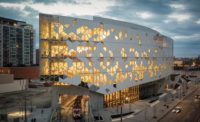
Central Library by Snøhetta and DIALOG

Two Buildings by COOKFOX Anchor a New Multi-Use Neighborhood With a Profusion of Greenery

Continuing Education: Mass Timber Construction Swatch Headquarters by Shigeru Ban
Using wood and mass timber in library and community projects, upgrading the existing home, the latest news and information, #1 source for architectural design, news and products.
Copyright ©2024. All Rights Reserved BNP Media.
Design, CMS, Hosting & Web Development :: ePublishing
Academia.edu no longer supports Internet Explorer.
To browse Academia.edu and the wider internet faster and more securely, please take a few seconds to upgrade your browser .
Enter the email address you signed up with and we'll email you a reset link.
- We're Hiring!
- Help Center

DI_74_CEPT Lilavati Lalbhai Library Building by RMA Architects

2018, DOMUS India
The Lilavati Lalbhai Library for CEPT University marks an interesting development in the new imagination of this iconic campus, as Kaiwan MEHTA discusses, bringing newer meanings to modern history of buildings in Ahmedabad and India.
Related Papers
Dr. Rajender Kumar
Kiran S A T Y A B O D H Kalamdani
PREFACE Being a student of nineteenth and twentieth century architecture one finds that the Victorian Period was rife with confusion and endless debates over the preferred styles of architecture. The riches that flowed into England from the colonies created an affluence that yielded one of the most productive phases of British architecture. The industrial revolution and the discovery of new material like steel and glass sought expression in the exhibition structures of the Crystal Palace of 1851 and the Eiffel Tower of 1889. The mainstream architecture was still clothed in a confusion of Greek, Roman and Gothic revivals. The name of James Trubshawe (the architect of this building and several others like the Engineering College, Law Courts and the General Post Office) hardly finds mention in books on Victorian Architecture. Even the more important ones like Sir Gilbert Scott and George Wittet find a passing reference. India was always peripheral to the interests of architects and architecture, a trend that was to be later changed by Sir Edwin Lutyens by the making of New Delhi (1920-1930). The confusion and lack of direction that prevailed during the period is evident in the work of the Government House in Pune. A Romanesque Revival exterior awkwardly accommodates a Georgian Interior. Local Stone, Indian fauna and a completely incongruous collection of furniture, paintings and other works of art create a mixed jamboree. The task of bringing 21st century sense in the use and presentation of the building is further complicated by the many structural and design defects that arise out of the Victorian roofscape. The many vines planted around the building added to the picturesque and romantic effect of the building, but they almost tore it down. They were ably assisted by the monsoons and bird-droppings. Bats, bees, rats, cats and termites that were in abundance in the virtual forest of the University Campus, have completed the scenario of picturesque decay in the absence of monitoring and maintenance systems. The cultural arrogance of the patrons of the building was evident in its plans and elevations. Politically the Marathas were last among Indians to be subdued and the first to rise against the foreign rule. They were made to witness the building of a Government House on a piece of land that was a hundred times larger than the Shaniwarwada (the citadel of the Peshwas – prime ministers of the Marathas, and the virtual capital of the country in the 18th century). If the original plans of Trubshawe assisting Frere were realized, there would have been a much larger building than the present one. Thanks to the end of the cotton boom, they had to be satisfied with a building modest in size. It finally cost one and a half times more than the annual turnover of the district at the time. The gardens and the wooded landscape, that remain one of Britain’s few contributions to the world of plastic arts, is an environmental blessing to overcrowded and polluted Pune. The excellent craftsmanship in the local basalt lends austere dignity to the building and commands respect that is needed for its present activity. The lavish use of gold-leaf and expensive teak wood paneling in the ceremonial halls inspires awe and bestows dignity on any assembly despite their faded elegance. The ball dances and banquets of the yesteryears have given way to meetings, seminars and lectures. Well-dressed officers and ladies of the colonial times are now replaced by elegant sari-clad women and simply dressed men. The historic distance that 58 years of independence has lent makes one look back with relative detachment. The Victorians who conceived of a flamboyantly modest architecture that borrowed heavily from the Greeks and Romans left back a legacy of strange fusion. Today we regard it as shared heritage, a reminder of mixed feelings for the past, with a certain belief that it will pave the way for a brighter future. The act of conservation is being undertaken with sufficient scrutiny of the nineteenth century builder’s craft, of values local and global, of lessons learn’t on what to do and what not to and why. Victorian literature is as rich as it is replete with the likes of Thomas Babington Macaulay (1800-59) who wrote the Minute on Indian education (Feb 2, 1835) and boasted that he had not found one Orientalist ‘who could deny that a single shelf of a good European library was worth the whole native literature of India and Arabia’. But it is from the likes of William Wordsworth (1770-1850)and Thomas Hardy (1840-1928) of the period that one derives the pleasures that are things of beauty – joy forever. Compared to the architecture of the Victorian Era it was the poets and literary giants who excelled in the art of the language and bring respect and dignity to the period. Edward Lear (1812 – 88) who visited India and also drew sketches of the Shaniwarwada and the temples near the Railway Station, was Britain’s wittiest and most attractive of children writers who gave drawing lessons to Queen Victoria! Charlotte and Emily Bronte, Christina Rossetti (1830-94) are some names who brought a rare aesthetic aroma to the world of English literature. John Ruskin (1819-1900), William Morris (1834-96), Charles Dickens (1812-70), Lewis Caroll (1832-98) and Oscar Wilde (1854-1900) are some of those shining jewels of Britains’ cultural diadem. While restoring the Main Building of the University of Pune we pay our tributes to these artists whose art transcended the boundaries of Culture and Nation to fill this small world with things of beauty. (Ref The Victorians, An Anthology of Poetry and Poetics, Editor Valentine Cunningham, Blackwell, London, 2000.) Conservation of buildings is a relatively new activity in India and as we enter into it with a new charter1 that addresses the complex and polemical issues on the ideology, there is a certain hesitation and also a challenge. Difficult choices between the beautiful, the historical, the technically correct or the culturally relevant mode of conservation have made the task as interesting as it is daunting. The desired material, technology or craftsmanship not being readily available makes the time lag in the procurement longer. The general system of estimation, tendering and management of work being derived from that of the PWD that is not geared to the task of conservation, or based on the premise of trust, is yet another impediment in the smooth progress of work. However the most encouraging support comes from the patrons who have egged the team to move on despite the odds. History of the city and the country took turns on the grounds on which the last Anglo-Maratha war was fought, where the building stands, where the University started 55 years ago. Today the grounds are poised for yet another change where we consolidate the gains of the past and forge our own future. Kiran Kalamdani Dec 2, 2005
IAEME PUBLICATION
IAEME Publication
Every building is a manifestation of the era in which it was constructed and has a history of its own. Established during the British Rule as a Survey School, the National Institute of Technology Patna is the 6 th oldest technical institute in India. Its administrative building, designed by W.C. Wright in Indo-Saracenic revival architecture is over a century old, and is one of the finest and rare examples of the style in Patna. Hence, this historical monument is worthy of a detailed architectural study. The objective of this paper is to review the salient features of the architectural and structural elements of this building though a detailed study.
grete pasch
In book: Library Planning, Administration and Management in the Present ScenarioEdition: 1st, 2021 Chapter: 1st Publisher: InSc Publishing House (IPH)
Hafijull Mondal
The construction of a library building is of initial and foremost step for designing a library or info centre because it cannot exist while not a correct building. The library building ought to be planned. The outside ought to be invitatory and therefore the interior ought to be engaging. The building ought to be useful and at identical time aesthetic. It ought to be useful one providing enough area for varied functions to fulfill the wants. The library building conjointly ought to be standard and will have the availability of future growth. New coming up with principles square measure needed to fulfill the dynamic wants of the users of the library of the longer term. The digital revolution has modified the looks of today's libraries entirely. The bulk of today's data resources square measure of a non-physical nature and accessing data is additional varied and complicated. The normal role as quality keeper is one in every of several tasks these days. In this chapter briefly discussed about why library building should be well planned with basic principle of library building design and some standards of library building design. Finally a discussion about space allocation, utilization and management with some new areas in modern library
ASHWANI KUMAR
Faizan Naqvi
We are mentioning these as the memorabilia of Lala Lajpat Rai in Lahore.Every construction and institution has had its own important role in history, a different feature will be published on this.
The swing of the pendulum between centralization and decentralization of the higher education (HE) system has generally been towards the former in the Iranian context in the past decade. This has prompted some academics, particularly those who find their disciplines left out to react by highlighting intrinsic differences in teaching and studying methods across the HE spectrum. Built Environment disciplines are no exceptions in this regard as their interdisciplinary nature has always made it difficult to classify them as science, art or engineering, and hence to expect research and study methods associated with either. The present research initially started not to highlight the differences between Built Environment and other libraries, but to scrutinize the ways in which this particular library is used. Further examinations cast light on managerial and cultural issues behind what authors believe to be the underuse of the library. However, the research also highlighted possible discip...
Indo Nordic Authors’ Collective
Dr. Uday Dokras
One of the finest architecture representing Buddhist culture and history is the Dhamma Chakra Stupa in Nagpur. Also referred to as Deeksha Bhumi, this structure is large enough to accommodate over 5000 people. This stupa is made of Dhaulpur sandstones, granites and marbles and is 120 feet tall.
Loading Preview
Sorry, preview is currently unavailable. You can download the paper by clicking the button above.
RELATED PAPERS
The Journal of Academic …
Mujdem Vural
Nancy Adajania
Thanuja C Ranawella
Muhammad Naushad G. Sabzwari
Australian Academic & Research Libraries
Ebrahim Afshar
ILA Newsletter
DOMUS India
DOMUS I N D I A (Editorial) , Suprio Bhattacharjee
Bibliothek Forschung Und Praxis
Johnson Paul
Journal of Heritage Management
Ritika Jharia
Journal of Indian Library Association
Dr. Manju Kalita
Md.Mizanur Rahman
Nirav Goyani
Bolanle Ishola
David Jones
London Metropolitan University, Nov 2009
Journal of Academic Librarianship
Berrin Küçükcan
CERN European Organization for Nuclear Research - Zenodo
Sangram Killedar
Randy K Schwartz
Journal of the Society of Architectural Historians
National Conference: Cultural Identities - Manifestation through Architecture (CIMA) 2020
Priyanka Gayen
ichank ditha
RELATED TOPICS
- We're Hiring!
- Help Center
- Find new research papers in:
- Health Sciences
- Earth Sciences
- Cognitive Science
- Mathematics
- Computer Science
- Academia ©2024

Lilavati Lalbhai Library at CEPT University Ahmedabad, India
The library acts as a living case study of passive climate mitigation strategies, high on the teaching agenda at CEPT University (formerly Centre for Environmental Planning and Technology). Its materials respect those of the campus’s existing buildings, and placing three of its six storeys underground keeps it within their height datum. Centrally located, it has separate and equal entrances on each side. Complete with an operating manual for students, its modulated, louvred façades can be manually adjusted to admit less light or more ventilation. First-floor reading rooms overlook the campus. Below-ground book stacks, carrels and study spaces benefit from plentiful natural lighting via the louvred façade and subterranean courtyard, as well as the natural cooling effect of the surrounding earth.
Source: Aga Khan Trust for Culture
- Architecture
- Competitions
- Events & Exhibitions
- Ambiente Cucina
- Come ristrutturare la casa
- Serramenti design e componenti

Lilavati Lalbhai Library by RMA
architect: RMA
location: Ahmedabad, Gujarat, India
Embedded in the heart of the CEPT University campus designed by B. V. Doshi, the CEPT Library is envisioned as a space for catalyzing connections between students and faculty of the various academic departments. Neutrally oriented at a central location with separate and equal entrances facing all cardinal directions, access to the building – and identification with it – is collective across the campus. Using the functional requirements of the library as an underlying contemporary theme, the building formally weaves itself into the preexisting campus narrative. Through alignments in plan with adjacent buildings, modulation of sectional levels into and above the earth, and honest material selection and expression, the building respects the continuum of existing architectural expression that has defined the CEPT University campus for decades. At the most fundamental performative level, the CEPT Library is a technologically adept repository of multi-format media, both responding to and anticipating the current and future acquisitions of the university.
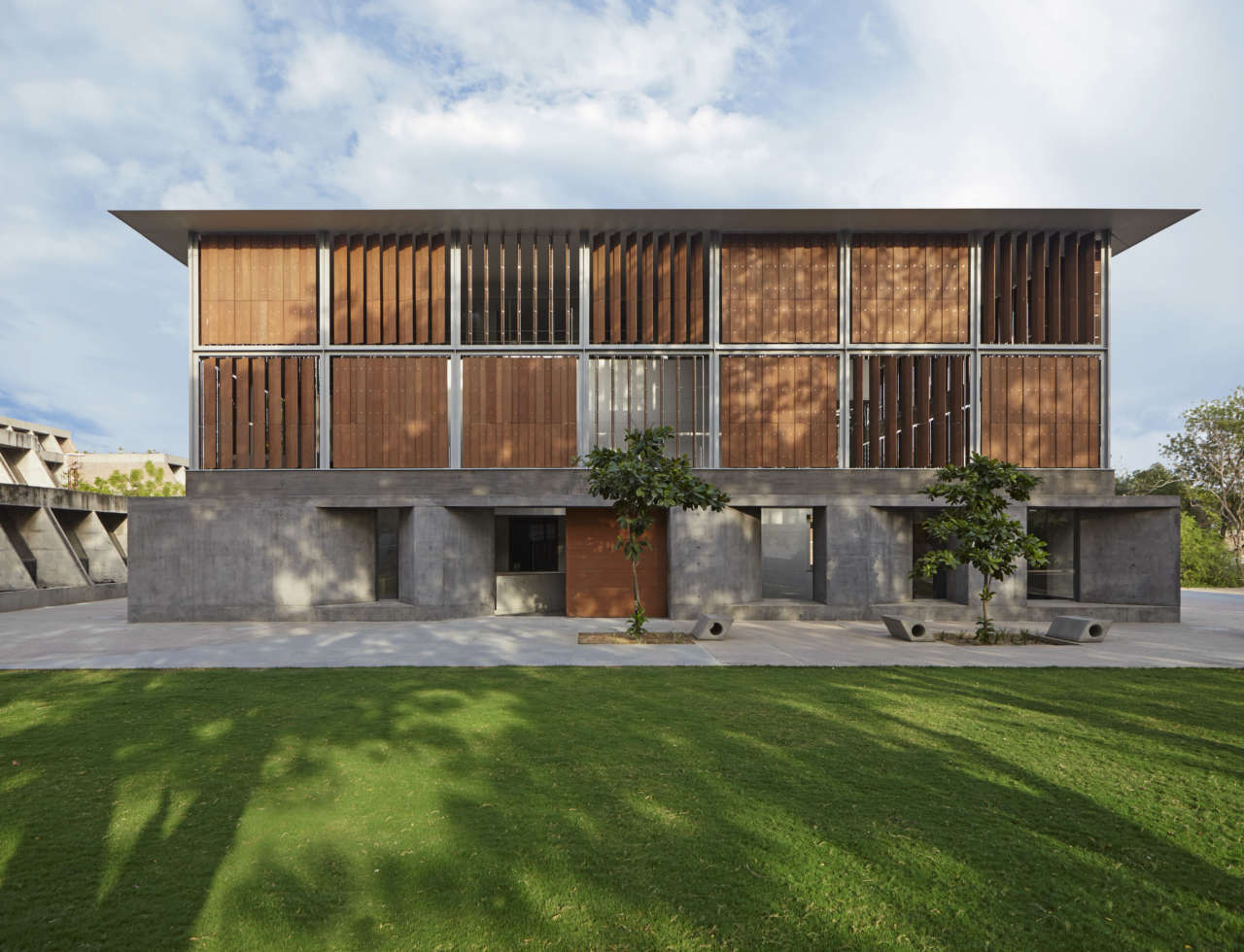
Reading rooms, formal and informal reading spaces, individual carrels, seminar rooms, and administrative offices are accommodated in addition to softer and more flexible functions such as exhibition and presentation spaces. The library is at once a built manifestation of the university’s ongoing shift away from a traditionally prescriptive pedagogy toward a choicebased curriculum, as well as a demonstration of passive climate mitigation strategies in architecture.
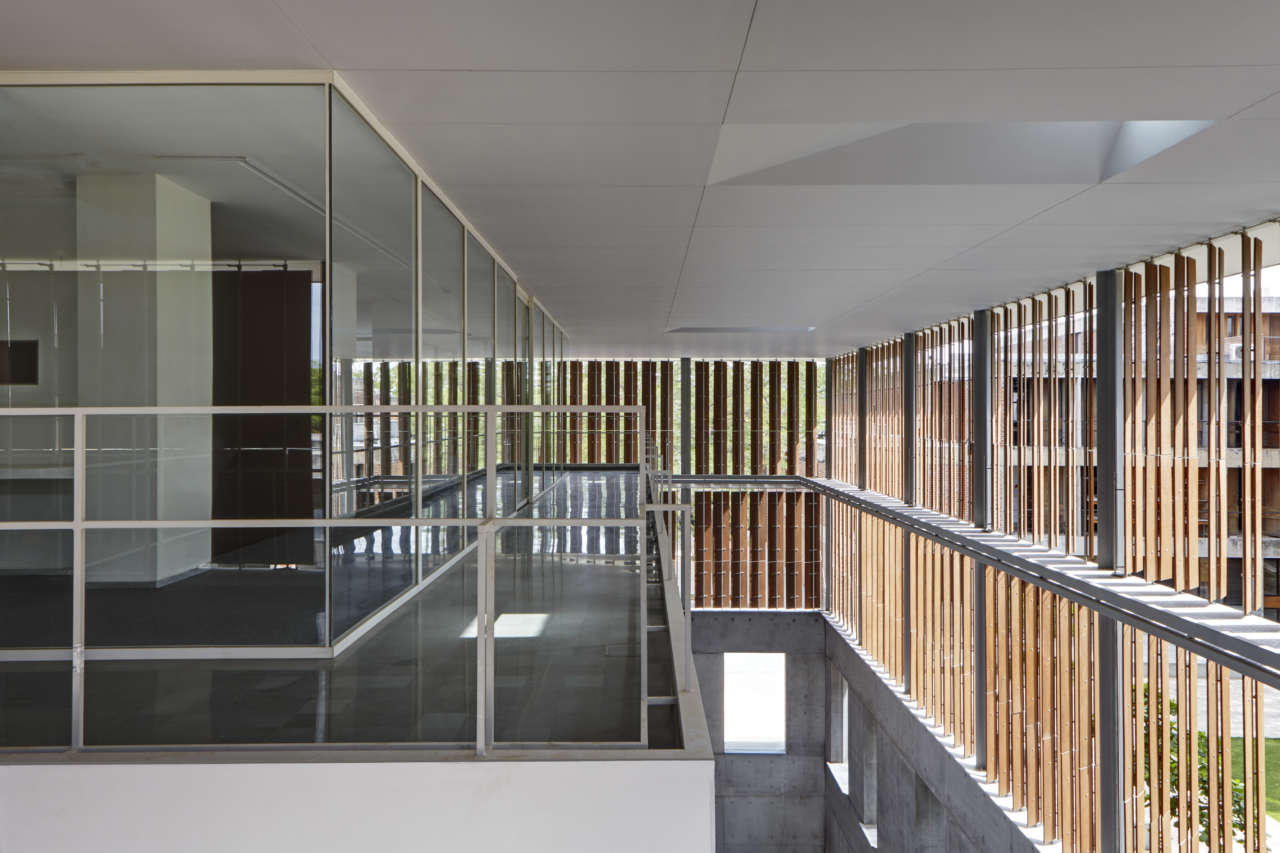
Complete with an operating manual for students, the building’s modulated, louvered facade can be manually adjusted to allow in less light or more ventilation in response to Ahmedabad’s severely hot and dry climate. Located at –4 meters and –8 meters below ground level, the book stacks, carrels, and study spaces benefit from both plentiful and filtered natural lighting that pours in through the louvered facade as well as the natural cooling effect provided by the surrounding earth. In this way, the building serves as a hands-on laboratory for students to experiment with the principles of passive ventilation, lighting, and traditional cooling systems in South Asia.
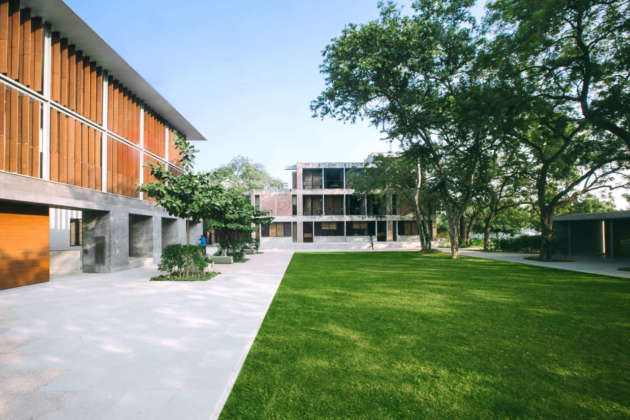
title Lilavati Lalbhai Library, CEPT University location Ahmedabad, Gujarat, India client Centre for Environment Planning and Technology (CEPT) dates 2015-2017 area 30.000 square feet project team Payal Patel, Robert Stephens, Jay Vadodaria, Akash Joshi, Prashant Saudagar consultants N.K. Shah Consulting Engineers LLP, Aakruti Architects, Arkk Consultants
RELATED ARTICLES MORE FROM AUTHOR
A gently gigantic art museum in china by junya.ishigami + associates, technological innovation in the luxury homeware sector, a house on the lake designed by collectiveproject.
- Disclaimer e note legali
- Informativa estesa sui cookie
RMA Architects
Ahmedabad, India
Cept university library, related posts.
- Architects in your City
- Famous Architects
- Ancient / Historical
- Corporates/offices
- Cultural/Religious
- Green/Sustainable Architecture
- High-rise/Skyscraper
- Hotel and Cafe
- Institutional
- Mixed-use Buildings
- Recreational
- Landscape Architecture
- Public Buildings
- Residential
- Top in the field
- Tech in Architecture
- Career Path
- Sign in / Join

Norman Foster and his High-tech Architecture
Diebedo francis kere- first african to win pritzker architecture prize, thomas heatherwick – fascinating architect, oscar niemeyer- hero of the modern architecture, chichu art museum: portrayal of japanese brutalism, biomimicry architecture: eastgate centre – harare, zimbabwe, vastu direction for home, top 10 fabulous wooden structures in the world, 10 upcoming futuristic projects in the world: a glimpse into architecture…, architecture of indian cities: top 10 cities for architects., are the skins of larger buildings prefabricated, what is 3d printing technology how it is used in architecture, the best designing software that every architect must use, best laptop for architecture students in 2021, 5 representations of technology in the world of architecture, unveiling the essence of architecture: a comprehensive exploration, architecture juries – 10 things to remember before them, top 20 architecture colleges in the world, top 20 architecture colleges in india, top 20 architecture colleges in canada, cept – school of architecture: the school of learning not for teaching.

CEPT- the School of Architecture is how it was started. Their first project done by the Ahmedabad Education Society with the help of the Ministry of Human Resource Development, the Government of Gujarat, and the Ford Foundation in 1962. And then they established further academics like faculty of planning, technology, design, and management. The school and the other academics came under the CEPT University in 2005. Until then it was affiliated under the Hemachandracharya North Gujarat University from 2002 to 2005.


Case Study of CEPT
Planning of cept, studios of cept, landscape at cept, library of cept, design philosophy of cept.
- Architect: Balakrishna. V. Doshi
- Funding: The Ahmedabad Education Society
- Aided by: The Ministry of Human Resource, the Government of Gujarat and the Ford Foundation
- Established: 1962
- Floors: 3 with multiple levels
- Floor Area: 700.15 sq. m (Faculty of Architecture)
- Site Area: 12.5 Acre
- Location: Ahmedabad, Gujarat

Among the congested heavy traffic city buildings of Ahmedabad, the college lies as one among the educational buildings in one corner and is 3.1km away from IIM Ahmedabad.
Being an architect, I have always questioned myself about what is architecture about. After visiting this place, I have realized that architecture is all about learning. Being designed under the guidance of the Pritzker prize-winning architect B.V. Doshi no wonder it is one of his masterpieces. The block is designed with the intention that architecture is about learning rather than teaching. Also, the planning makes us feel confusingly interesting by playing with different levels on the campus. So the lawn in front of the block with a hilly look is used for public interaction. The main concept of the block is to make interactive spaces instead of just making classrooms and studios.

The major compliment of the building is it is still evolving. Its main concept is open, simple, and interactive. The building is largely opened to outer space to provide interaction among the students of different classes. The building has a simple look which is the main theme to provide low-cost construction with a high-quality environment. As we said before the building has more interactive space to give the space to learn more things among the students.
Also, Read: Salk Institute – A Louis Kahn Masterpiece
The building is built with a load-bearing structure with 750mm thick cross walls. While the beams of the slab run through the east-west direction the partition walls run through the north-south direction. Without any ornamentation, the surface of the building contains exposed bricks and concrete. Not many materials were also used. There are just bricks, concrete, wood, mild steel, and glass were used in the construction. Also, these construction components provide thermal comfortability to the built environment. The thick walls provide heat insulation to the interiors of the building.

Spaces of CEPT
The basement is mainly a multipurpose area. The students play and interact with each other in this space. As they don’t have any hindrance in between they can use for cultural activities too.

With a large opening to the outer space, the studio is abundantly filled with light during the day. There are panels on the walls which help the students to put up their works and explain them. Every studio of different classes is in different levels which metaphorically speaks about the level up for the different years of the classes. The classes are of double heights with wide openings giving high ventilation to the studios.

There is an open courtyard in the center that connects the library, studios, art exhibit, and workshop. It also plays a major interactive space with a play court on one side and also pavements in the outer which connects every block.

Also, Read: Habib University- Design A Learning Community
There are trees surrounding the campus which provide a perpetual changing pattern of light and shade. Also, the blocks interconnect through brick paving and terracotta tiles. However, the varying levels are maintained by steps in between which itself becomes the common interactive space. Also, at one side of the courtyard, the sky is covered by clothes that are connected by strings below where the students play outdoor games.
The interior design by the students’ creative ideas is hanging from the roof and the walls. There is also a play with light and shadow, especially in the corridors. Some places receive direct sunlight while some places receive no sunlight at all.

The outer of the library is made of the changing walls which can be turned and opened. Thus, the view from the inside of the library would be pleasant to feel the natural light and shadow. However, the library doesn’t contain brick walls for the outer side. They are actually made of concrete which is also exposed. The library does not have any windows because the outer walls themselves act as one. This block was constructed only later.

The stairs at the rear side of the main building also give us an interesting pattern where there is a basement lead under the staircase. Also, those surprise staircases lead to the first floor of the main building. Moreover, the staircase is constructed completely with reinforcement.

The main aim for the architect is to produce better architects for society by not just recruiting highly qualified teachers but also providing a better environment to learn. However, the major difference between other colleges and architecture colleges is that the students of architecture have to stay in their blocks and work for 24hrs of the day too. Hence much care is to give while designing a school for architects. They have to be provided with recreational space, interactive space, and workspace combined together. We the architects are the people working in art combined with science. Hence, we are partial artists. The art should not teach in a closed non-creative environment made of just white boxes. However, there is art in every artist which should be fed every time.

In addition, the three texture walls, exposed façade, and the interiors, varying floor levels, interactive spaces, open courtyard, and beautiful lawns everything gets combined to give us a beautiful workspace for the students of architecture. No wonder Sir B.V. Doshi is one of the legends.
Also, Read: Aranya Art Center

Don’t miss the latest case study!
We don’t spam! Read our privacy policy for more info.
You’ve been successfully subscribed to our newsletter!
Share this:
- Click to share on WhatsApp (Opens in new window)
- Click to share on Twitter (Opens in new window)
- Click to share on Facebook (Opens in new window)
- Click to share on LinkedIn (Opens in new window)
- Click to share on Pinterest (Opens in new window)
- Click to share on Tumblr (Opens in new window)
- Click to share on Telegram (Opens in new window)
- Click to email a link to a friend (Opens in new window)
- Click to print (Opens in new window)
Discover more from archEstudy
Subscribe to get the latest posts to your email.
Type your email…
RELATED ARTICLES MORE FROM AUTHOR
Glassell school of art, kala academy, goa – a well built unbuilding, educational intervention – rajkumari ratnavati girl’s school .
[…] Also read: CEPT – School of Architecture: The School of Learning Not For Teaching […]
Leave a Reply Cancel reply
Most viewed posts.
- archEstudy Privacy Policy
- Terms & Conditions
Subscribe now to keep reading and get access to the full archive.
Continue reading
- Hispanoamérica
- Work at ArchDaily
- Terms of Use
- Privacy Policy
- Cookie Policy
CEPT University Foundation Hall, Lecture Hall and Kund / CCBA Designs

- Curated by Hana Abdel
- Architects: CCBA Designs
- Area Area of this architecture project Area: 53852 ft²
- Year Completion year of this architecture project Year: 2022
- Lead Architects: Prof. Christopher Benninger
- Structural : N. K. Shah Consulting Engineers LLP.
- Acoustics : Sonics
- Rain Water Harvesting : M. S. Consultants
- MEP : Prachtvoll Engineers pvt. ltd
- Furnishings : TDW Furniture. Pvt. Ltd , Ismet Khambatta
- Design Team: Prof. Christopher Benninger, Shivaji Karekar, Neeraj Nijampurkar (
- Landscape: Landscape: Ravi & Varsha Gavandi
- Engineering Coordination: Rahul Sathe
- Text: Venessa Thomas
- Program / Use / Building Function: Educational
- City: Ahmedabad
- Country: India
- Did you collaborate on this project?

“Originally from the USA, celebrated Indian Architect and Planner, Prof. Benninger's architectural journey mirrors the life of a dedicated scholar. His firm ' CCBA Designs' based in Pune, is a multi-disciplinary design company renowned for its innovative and contextually sensitive creations. Since its inception, the firm has created a great number of institutions around the world, harbouring the identity and symbolic relationship between the built environment and the social fabric. Their latest endeavour brings them back to Benninger’s beginnings in India.

The Symbolic Endeavour: New Academic Block in CEPT University - Located adjacent to the School of Architecture, the new block is designed to reinforce the cultural continuity of the existing campuses architectural language and consists of rectangular juxtaposed volumes containing three components:
- The Foundation Center
- The Lecture Hall
The new block fosters a sense of physical and visual connectivity with the iconic grass hillock and School of Architecture next door. The Foundation Centre and the Lecture Hall are perched in an L-shaped layout on the site and envelope the Kund that ties the two together by harboring a new activity hub for the campus.

The Foundation Center- The Foundation Center is a double-storey structure that continues the play of open-plan layouts of the existing campus. Designed to house six studios and six classrooms that accommodate around 300 students, the design follows the celebrated material palette of exposed bricks and concrete, synonymous with the identity of the campus and the architectural language of modern Ahmedabad . Two staircases at either end of the structure lead to the Foundation Studios upstairs. They are set deep inside the volumes to tackle the harsh Ahmedabad heat and open up to balconies that frame the facade of the building.

The spatial functionality of the studios adopts a similar open layout borrowed from its sister building, the School of Architecture by B. V. Doshi. Reflecting the traditional architectural heritage of the city, exposed concrete jack arches are incorporated and flanked by skylights on either side to improve the natural lighting. Frosted glass flooring is used in the passageways to increase light filtration through the volumes.

The Lecture Hall: an Auditorium - The Lecture Hall is a single-story structure with a capacity to accommodate 450 students. Its warm interiors are further heightened by its wooden furnishings, which were conceptualized and designed by Ismet Khambatta’s 'The Design Workshop.’ The use of colored glass for its boxy openings creates a colorful chiaroscuro effect in the backdrop.

The Kund: a hub for activities - The Kund is an open-air amphitheater and student activity center. It takes on a dual role of function through careful space planning by primarily functioning as a gathering space for students year-round while quietly transforming into a rain-water pit during heavy monsoon, mimicking traditional Amdavadi step wells. The water from the whole campus is drained here and is used for ground-water recharge later, thus making the design intervention adapt to the seasonal changes of the city.

The Murals: an artistic expression - For Prof. Benninger, murals play a very important role. The new academic block features a large number of murals cast in situ on its concrete ceilings. These act as personalized notes given by the architect himself to the young students to foster an ever-growing curiosity to learn and observe one’s surroundings. Some of them include Le Corbusier’s famous ' Modulor Man', and Benninger’s own 'Principles of Intelligent Urbanism'. The Modulor Man is a human figure synthesizing a universal system of proportions, while the Principles of Intelligent Urbanism is a theory composed of a set of ten axioms intended to guide the formulation of city plans and urban designs.

The architectural vocabulary of the new block is dictated by the context of modern architectural heritage in which the structure has been built. Thus, instead of diverging from the material palette, the project uses standard materials in innovative ways. The building borrows materiality, scope, and expression from the site and builds upon the environs to create a masterpiece that would not only blend with the fabric but complement the aesthetic and legacy of the campus.”

Project gallery

Project location
Address: ahmedabad, gujarat, india.

Materials and Tags
- Sustainability
世界上最受欢迎的建筑网站现已推出你的母语版本!
想浏览archdaily中国吗, you've started following your first account, did you know.
You'll now receive updates based on what you follow! Personalize your stream and start following your favorite authors, offices and users.
Check the latest Desks Privacy Furniture
Check the latest Desks Bureaus
INFLIBNET's Institutional Repository
Welcome to institutional repository of inflibnet centre, here you can find articles published in all conventional proceedings of inflibnet centre, more over you can also look for various training material,press clippings,news letters etc.
- IR @ INFLIBNET
- INFLIBNET's Convention Proceedings
- 26th International Symposium ETD 2023
| Title: | Restructuring and Upgradation of the DSpace-based Institutional Repository of CEPT University Library: A Case Study |
| Authors: | |
| Keywords: | CEPT Repository DSpace Electronic Theses and Dissertations (ETD) Institutional Repositories |
| Issue Date: | 17-Nov-2023 |
| Publisher: | INFLIBNET Centre, Gandhinagar |
| Abstract: | This paper aims to present a strategic overview of the restructuring of the CEPT repository structure, maintaining and upgrading its software for continuous access and improved services. The process of restructuring and upgrading CEPT University Library's repository to DSpace 7 involved identifying the need for technical proficiency, establishing a new server, configuring the repository, and migrating existing data while preparing metadata. Furthermore, data in the new storage hierarchy was restructured, and SSL integration with Shibboleth was implemented. The paper highlights the benefits and outcomes of the restructuring process, emphasizing the enhanced accessibility, discoverability, and preservation of scholarly works. The study discusses the challenges faced by the institution's existing repository, the rationale behind the restructuring, and the step-by-step approach taken to upgrade the repository. The case study serves as a valuable reference for other academic institutions seeking to optimize their institutional repositories. |
| Description: | 26th International Symposium, ETD 2023, Gandhinagar, Gujarat, 26-28 October, 2023 |
| URI: | |
| ISBN: | 9789381232125 |
| Appears in Collections: | |
| File | Description | Size | Format | |
|---|---|---|---|---|
| 350.04 kB | Adobe PDF |
Items in DSpace are protected by copyright, with all rights reserved, unless otherwise indicated.

- Advanced Search
Enhancing sign language recognition using CNN and SIFT: : A case study on Pakistan sign language
New citation alert added.
This alert has been successfully added and will be sent to:
You will be notified whenever a record that you have chosen has been cited.
To manage your alert preferences, click on the button below.
New Citation Alert!
Please log in to your account
Information & Contributors
Bibliometrics & citations, view options, recommendations, automatic sign language analysis: a survey and the future beyond lexical meaning.
Research in automatic analysis of sign language has largely focused on recognizing the lexical (or citation) form of sign gestures as they appear in continuous signing, and developing algorithms that scale well to large vocabularies. However, successful ...
American Sign Language Recognition for Alphabets Using MediaPipe and LSTM
With the advancement of today's technologies in artificial intelligence, humans tend to use hand gestures in their communication to convey their ideas. Gesture recognition is an active area of research in the human-computer interface (HCI). ...
Multi-scenario gesture recognition using Kinect
Hand gesture recognition (HGR) is an important research topic because some situations require silent communication with sign languages. Computational HGR systems assist silent communication, and help people learn a sign language. In this article, a ...
Information
Published in.
Elsevier Science Inc.
United States
Publication History
Author tags.
- Pakistan sign language
- Urdu Alphabets
- Hand gesture recognition
- Research-article
Contributors
Other metrics, bibliometrics, article metrics.
- 0 Total Citations
- 0 Total Downloads
- Downloads (Last 12 months) 0
- Downloads (Last 6 weeks) 0
View options
Login options.
Check if you have access through your login credentials or your institution to get full access on this article.
Full Access
Share this publication link.
Copying failed.
Share on social media
Affiliations, export citations.
- Please download or close your previous search result export first before starting a new bulk export. Preview is not available. By clicking download, a status dialog will open to start the export process. The process may take a few minutes but once it finishes a file will be downloadable from your browser. You may continue to browse the DL while the export process is in progress. Download
- Download citation
- Copy citation
We are preparing your search results for download ...
We will inform you here when the file is ready.
Your file of search results citations is now ready.
Your search export query has expired. Please try again.
S 2024 M 2023 S 2023 M 2022 S 2022 M 2021 S 2021 M 2020 S 2020 M 2019 S 2019 M 2018 S 2018 M 2017 S 2017 M 2016
Your browser is out-of-date!
For a richer surfing experience on our website, please update your browser. Update my browser now!
- DESIGNING A LIBRARY
Parikh Bhavya Snehal
'Designing a structure' started with initially learning the basics of structures like the forces that act, the types of active structures and how a material works. We, then moved to an exercise where we had to design an form active structure with the material we had been working with (I had brick). Then, we designed a system and had to cover it 50%. Our final exercise was to design a program in Gulbai Tekra Locality. I designed a library. To see the portfolio click here .
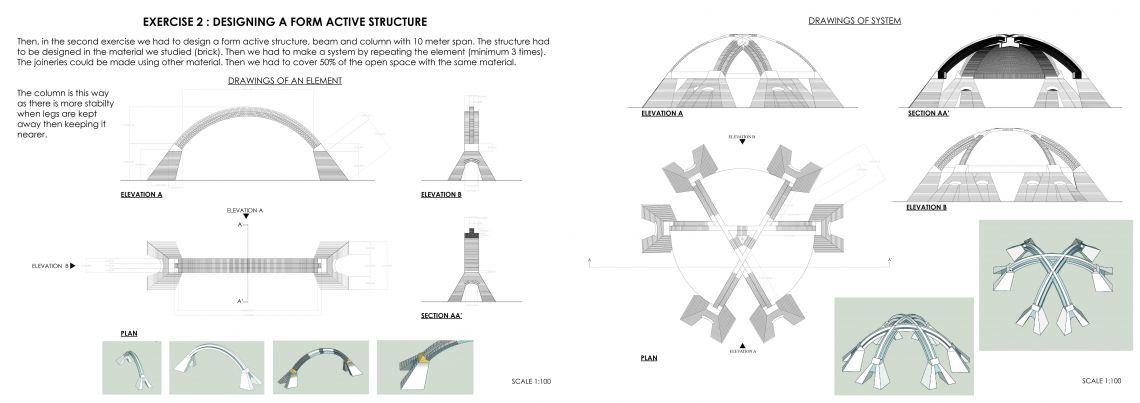
DESIGNING AN ELEMENT AND SYSTEM : (MATERIAL:BRICK) Drawings
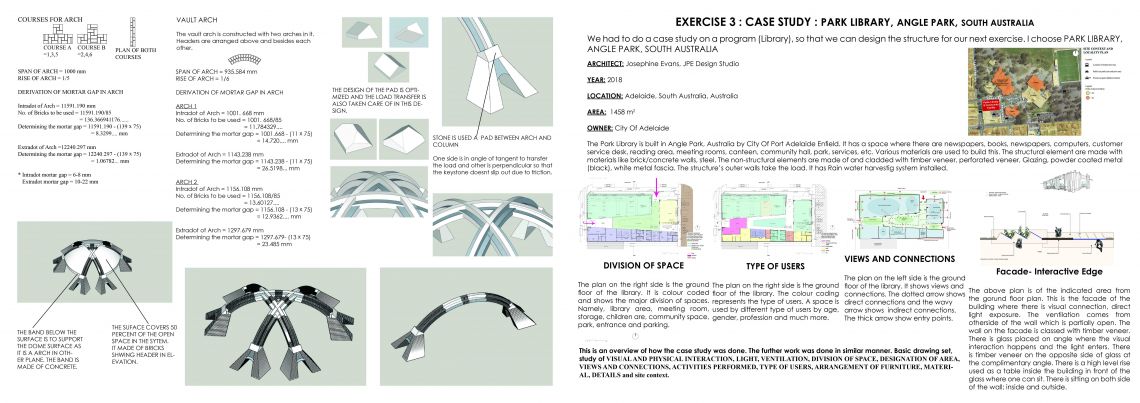
DESIGNING AN ELEMENT AND SYSTEM : (MATERIAL:BRICK) Details (Left side) CASE STUDY Park Library, Angle Park, South Australia (Right Side)
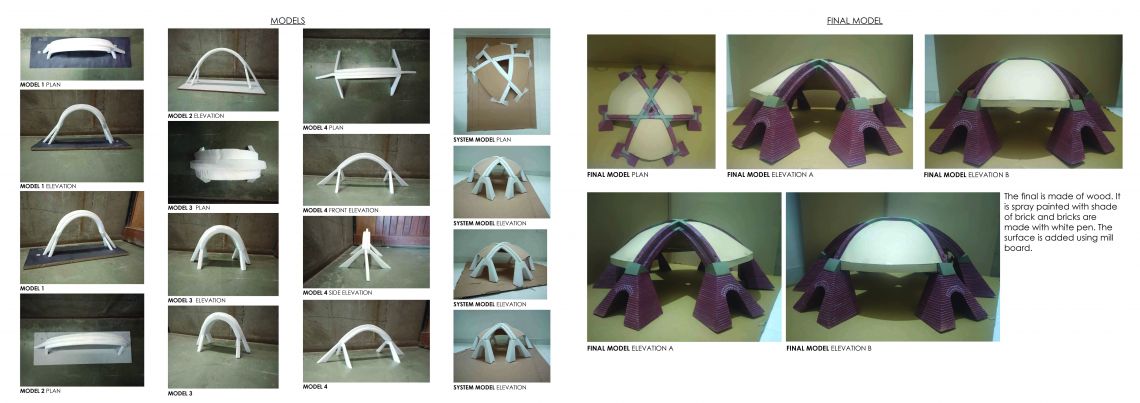
DESIGNING AN ELEMENT AND SYSTEM : (MATERIAL:BRICK) Model

DESIGNING A LIBRARY : Plans
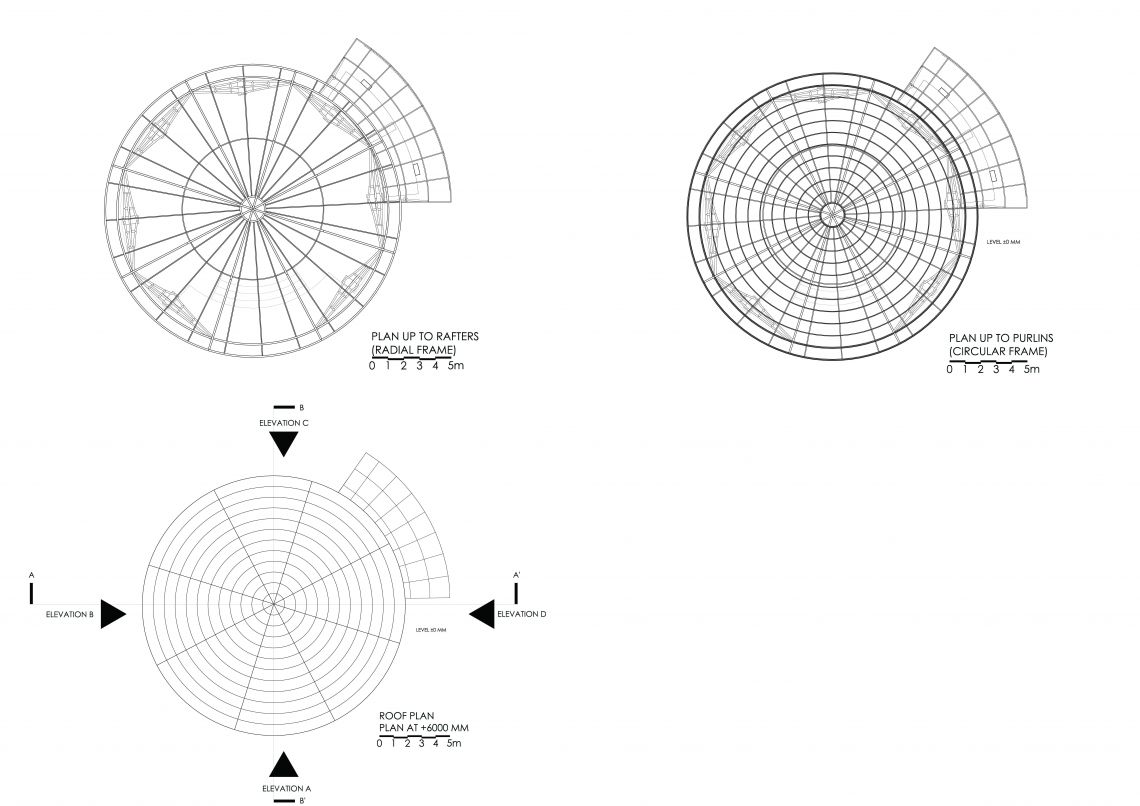
DESIGNING A LIBRARY : Elevations and Sections
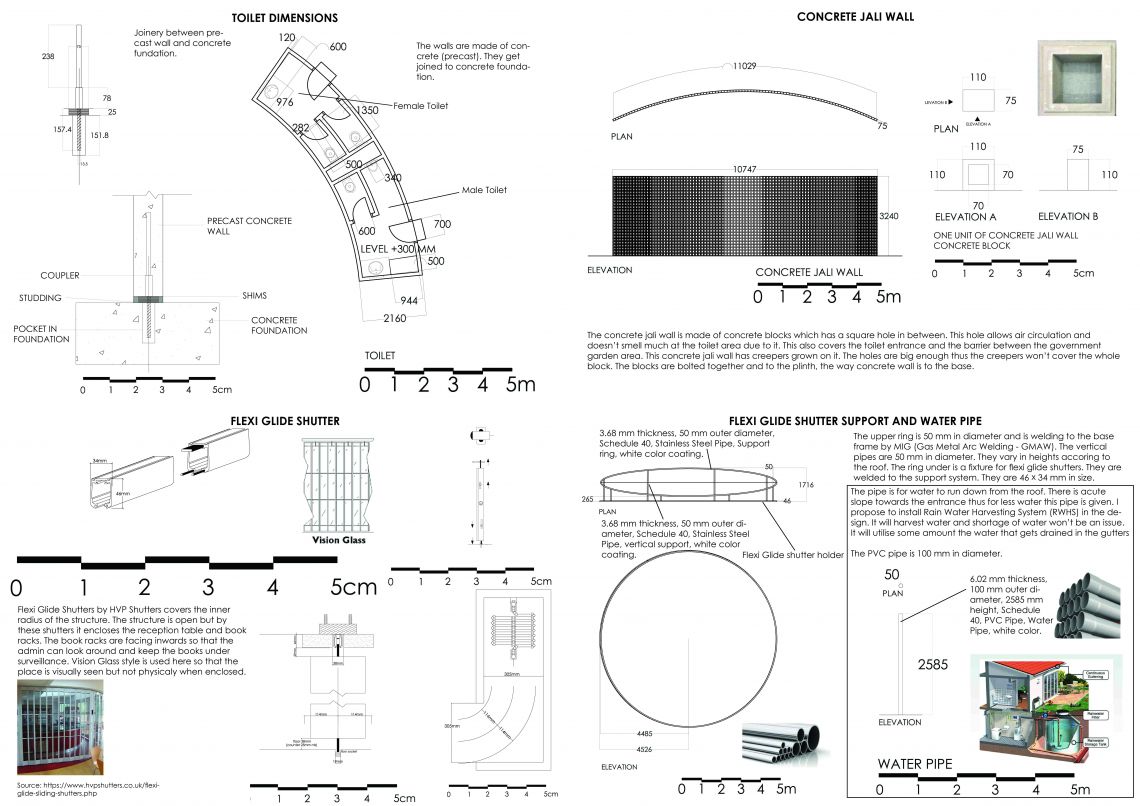
DESIGNING A LIBRARY : Details
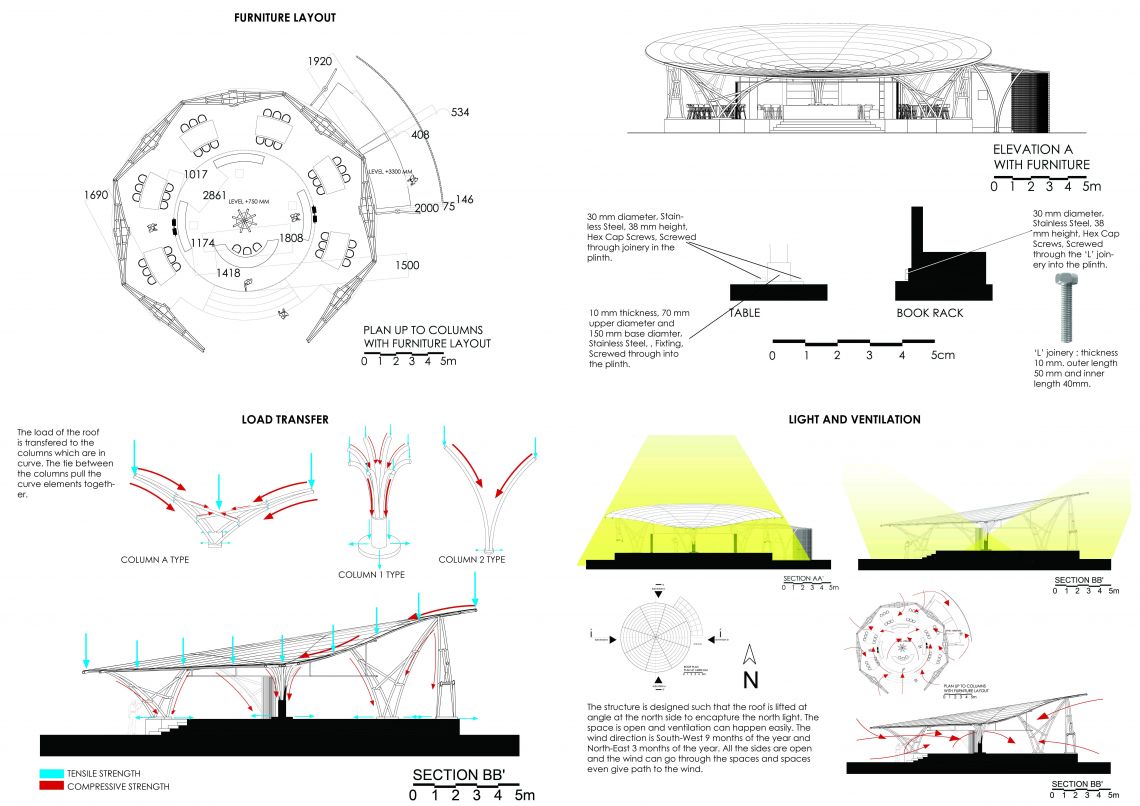
DESIGNING A LIBRARY : Views
Report inappropriate content.

IMAGES
VIDEO
COMMENTS
The CEPT University Library, called the Lilavati Lalbhai Library, opened in 2017. It was the first structure on the CEPT campus that architect BV Doshi had not designed, and architect Rahul Mehrotra—an alumnus of CEPT, and Lead Architect of RMA Architects—says that he found this intimidating and challenging.
Completed in 2017 in Ahmedabad, India. Images by Rajesh Vora, Tina Nandi. Embedded in the heart of the CEPT University campus designed by B. V. Doshi, the CEPT Library is envisioned as a space for ...
February 1, 2018. Architects & Firms. RMA Architects. The Centre for Environmental Planning and Technology (CEPT), in Ahmedabad holds a special place in the hearts and minds of the generations of architects who have studied there since the school's beginnings in the early 1960s. Designed by famed Indian architect Balkrishna Doshi, now age 90 ...
Feb 3, 2022 • Download as PPTX, PDF •. 12 likes • 25,808 views. A. AparnaGupta92. This is an Architectural case study on the Centre for Environment Planning & Technology (CEPT) building. Situated in Ahmedabad, Gujarat. This is done by an architecture student in semester 5.
5113. Lilavati Lalbhai Library,CEPT University. It is a iconic 5 storey library building within CEPT University Campus. With increasing intake of students, the institute as an infrastructural space needs changes. Also, a 'Library Building' is often the symbol of grandeur of a famed educational institution. Thereby, CEPT with its grawing stature ...
The library acts as a living case study of passive climate mitigation strategies, high on the teaching agenda at CEPT University (formerly Centre for Environmental Planning and Technology). Its materials respect those of the campus's existing buildings, and placing three of its six storeys underground keeps it within their height datum.
VIKRAM A SARABHAI COMMUNITY SCIENCE CENTER 11 8 9 Site Plan 0 4 8 20 Left: The library building formally weaves itself into the pre-existing campus narrative and as a result, respects the continuum of existing architectural expression that has defined the University's campus for decades Photo Tina Nandi Project: Lilavati Lalbhai Library, CEPT ...
Lilavati Lalbhai Library at CEPT University. The library acts as a living case study of passive climate mitigation strategies, high on the teaching agenda at CEPT University (formerly Centre for Environmental Planning and Technology). Its materials respect those of the campus's existing buildings, and placing three of its six storeys ...
first floor plan. section. section. title Lilavati Lalbhai Library, CEPT University. location Ahmedabad, Gujarat, India. client Centre for Environment Planning and Technology (CEPT) dates 2015-2017. area 30.000 square feet. project team Payal Patel, Robert Stephens, Jay Vadodaria, Akash Joshi, Prashant Saudagar.
CEPT University Library. Completion Date:2017. TYPOLOGY. Featured-BelowFeaturedInstitutions. Learn Moresite by 67a2 media© RMA Architects. RMA Architects sees a multiplicity of experiences, modes of engagement with practice, and working with varied constituencies as necessary for the evolution of culturally-specific design solutions.
A library is a centre of knowledge and wisdom and thus it's need in the new age of technology is important so that it does not loose its essence. It is important for a community to grow. The walls act as storage shelves themselves. It is a module of 1200mmX2400mm making it easier to stack, assemble, transport and construct, all of these being ...
CEPT Library Services are responsible for the maintenance of the Lilavati Lalbhai Library and all of the resources it contains. It also supports faculty members and students in enriching the teaching, learning and research experience at the University. The Lilavati Lalbhai Library forms the key material resource of CEPT University. We are ...
RESTRUCTURING AND UPGRADATION OF THE DSPACE-BASED INSTITUTIONAL REPOSITORY OF CEPT UNIVERSITY LIBRARY: A CASE STUDY 3.4 Configuration The new repository layout was designed to align with the defined criteria and branding directives of the university. CEPT University has a branding policy to develop and manage any web page, like logos, fonts,
The document provides an architectural case study of CEPT University in Ahmedabad, India. It describes the following key details: - CEPT was founded in 1962 and was influenced by the designs of Louis Kahn and Le Corbusier, adopting an open plan concept.
The CEPT University Library, known as Lilavati Lalbhai Library, is integral to CEPT University's mission of fostering teaching, learning, scholarship, and research. Serving as a bustling hub on campus, it offers an environment conducive to knowledge advancement, exploration, and engagement. With a focus on architecture and the built environment ...
Doshi. Funding: The Ahmedabad Education Society. Aided by: The Ministry of Human Resource, the Government of Gujarat and the Ford Foundation. Established: 1962. Floors: 3 with multiple levels. Floor Area: 700.15 sq. m (Faculty of Architecture) Site Area: 12.5 Acre. Location: Ahmedabad, Gujarat. CEPT - School of Architecture.
Completed in 2022 in Ahmedabad, India. Images by Ashish Bhonde, Ramprasad Akkisetti. "Originally from the USA, celebrated Indian Architect and Planner, Prof. Benninger's architectural journey ...
Library observes all the holidays as per the CEPT University Calendar. LIBRARY COLLECTION AT A GLANCE Books40000+ BoundJournals ... o Case studies/ Reportsrequest o Document ... o Inter LibraryLoan o Access Issues Contact: [email protected] Phone : +91 79 6831 0000 Extn: 120. Your suggestions and feedback are important for thelibrary ...
Deepika Srivastava. 2018. M J Library. The project involves the upgradation of the existing library, which includes restoration of the old building and improving the courtyard and the new building for better function and better aesthetics.The basic programmatic requirements include reading rooms with e-books and audio books (for the blind ...
Restructuring and Upgradation of the DSpace-based Institutional Repository of CEPT University Library: A Case Study: Authors: Dobariya, Namrata Doctor, Gayatri: Keywords: CEPT Repository ... and the step-by-step approach taken to upgrade the repository. The case study serves as a valuable reference for other academic institutions seeking to ...
ceptfinalppt1-171109130258 (1) (2)-converted - Free download as Powerpoint Presentation (.ppt / .pptx), PDF File (.pdf), Text File (.txt) or view presentation slides online. This document provides details about the Centre for Environmental Planning and Technology (CEPT) University campus in Ahmedabad, Gujarat, India. It was designed by architect B.V. Doshi on a 12.5 acre site located near ...
Search ACM Digital Library. Search Search. Advanced Search. Journal of King Saud University - Computer and Information Sciences ... A case study is demonstrated in the assessment of the system that has been provided. Finally, a comparison is performed between others and our work to show the efficiency of the proposed framework and legitimize ...
CT2020. LIBRARY. For designing the modules, various design principles were applied. Two independent volumes were clubbed together to achieve the final design comprising of the main Library. Various details such as gutter and gargoyles, skylight, railing, flooring, lintel and sill, typical brick course plan for the whole building, squinch, and ...
IR2002. DESIGNING A LIBRARY. 'Designing a structure' started with initially learning the basics of structures like the forces that act, the types of active structures and how a material works. We, then moved to an exercise where we had to design an form active structure with the material we had been working with (I had brick). Then, we designed ...